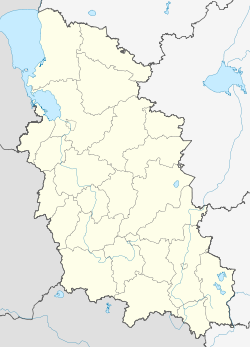Gdow
| city
Gdow
Гдов
|
||||||||||||||||||||||||||||||||||||
|
||||||||||||||||||||||||||||||||||||
|
||||||||||||||||||||||||||||||||||||
| List of cities in Russia | ||||||||||||||||||||||||||||||||||||
Gdow ( Russian Гдов ) is a small town in the Pskov Oblast ( Russia ) with 4379 inhabitants (as of October 14, 2010).
geography
The city is located about 125 kilometers north of the Oblast capital Pskow not far from the confluence of the Gdowka in the Peipussee .
Gdow is the administrative center of the Rajons of the same name .
The town is the terminus of a 1940 completed 100-kilometer railway line , which at Weimarn of the route Saint Petersburg - Tallinn , at the time but not branches in operation. A Narva- Pskow line from the direction of Pskow, built in 1916, was destroyed in World War II and later not restored.
history
Gdow was first mentioned at the beginning of the 14th century as the northern outpost of the Pskov Republic . In 1431 a fortress was built on the lower Gda , as the river was called at that time. Gdow was conquered several times by Lithuanian and Swedish troops.
From 1617 it belonged again to Russia and received city rights in 1780.
During the Second World War , Gdow was occupied by the German Wehrmacht on July 19, 1941 and recaptured on February 4, 1944 by troops of the Leningrad Front of the Red Army as part of the Leningrad-Novgorod Operation .
Population development
| year | Residents |
|---|---|
| 1897 | 2106 |
| 1926 | 3839 |
| 1939 | 4578 |
| 1959 | 3692 |
| 1970 | 4134 |
| 1979 | 4751 |
| 1989 | 6009 |
| 2002 | 5171 |
| 2010 | 4379 |
Note: census data
Culture and sights
In addition to the remains of the fortress from the 15th century, various buildings from the 19th century have been preserved. In the 1980s in was World War II destroyed Church of Derschawnaja-Icon of Our Lady , an excellent example of the Pskov architecture of the 15th century, rebuilt the original.
The city has a museum of the history of the area called Museum of Local History.
In the nearby village Kjarowo the former country estate of General P. Konownizyn, a participant of is Russian-Swedish War of 1808-1809 and the Patriotic War of 1812. In the village Domoschirka the is Trinity Church ( Троицкая церковь / Troitskaya Tserkov) from the 15th century. Century.
economy
In Gdow there are companies in the food industry ( fish processing , canned vegetables, dairy).
Bus routes connect Gdov with Pskov and Saint Petersburg.
Web links
- Gdow on mojgorod.ru (Russian)
- On the history of the Gdow fortress (Russian)
Individual evidence
- ↑ a b Itogi Vserossijskoj perepisi naselenija 2010 goda. Tom 1. Čislennostʹ i razmeščenie naselenija (Results of the All-Russian Census 2010. Volume 1. Number and distribution of the population). Tables 5 , pp. 12-209; 11 , pp. 312–979 (download from the website of the Federal Service for State Statistics of the Russian Federation)
- ↑ Gdovskaya Zarja (Гдовская Заря). April 24, 2016, Retrieved March 19, 2018 (Russian).
- ↑ Bus routes in Gdow. Retrieved March 19, 2018 (Russian).





